Sentiment Analysis
In this section, we will examine tweets related to one of the most popular NFT collections, Bored Ape Yacht Club. By analyzing public opinions of this collection, we can gain a better understanding of the public sentiment towards it.
Methodology
1. Scrape the data about tweets that include “BoredApeYC” (Due to the limitation of Twitter API, we cannot access to the tweets directly, thus we use the scraped data from KAGGLE for substitution)
2. Divide the file into sections that are readable by the Nocode Function website
3. Classify the text into different sentimental categories
4. Calculate the proportion of each category
5. Import VaderSentiment and SentimentIntensityAnalyzer and calculate the sentiment score for each tweet, and sort them out by descending order
6. Analyze the word cloud of each sentiment category and identify high-frequency keyword
7. Find out the reasons for the significant difference in public attitudes towards the BAYC collection
World Cloud of All Text
After cleaning and recoding the data, I generated a word cloud of the text. The resulting graph is shown below.

From the graph, we can see that the words frequently mentioned with BoredApeYC can be divided into the following categories:
l Main accounts of NFT
l Producers/Artists related to the BoredApeYC collection
l Platform: OpenSea
l Descriptive words: token, NFT, project
l Sentimental word: love
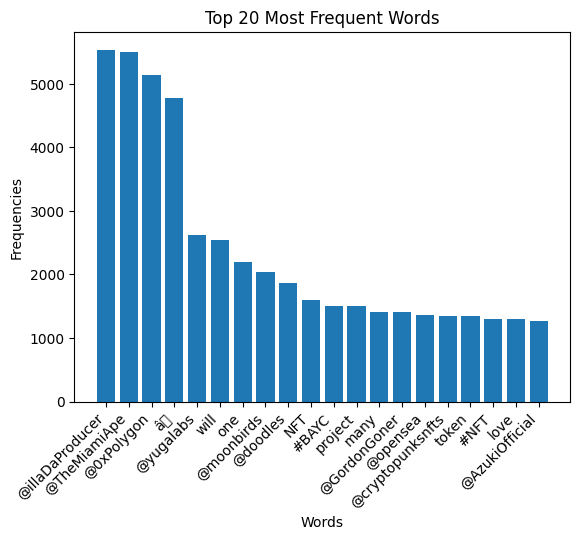
Sentiment Analysis by Categories
Most of the public does not have a clear emotional trend towards this collection. However, compared to a small group of people, the overall emotional direction is positive.
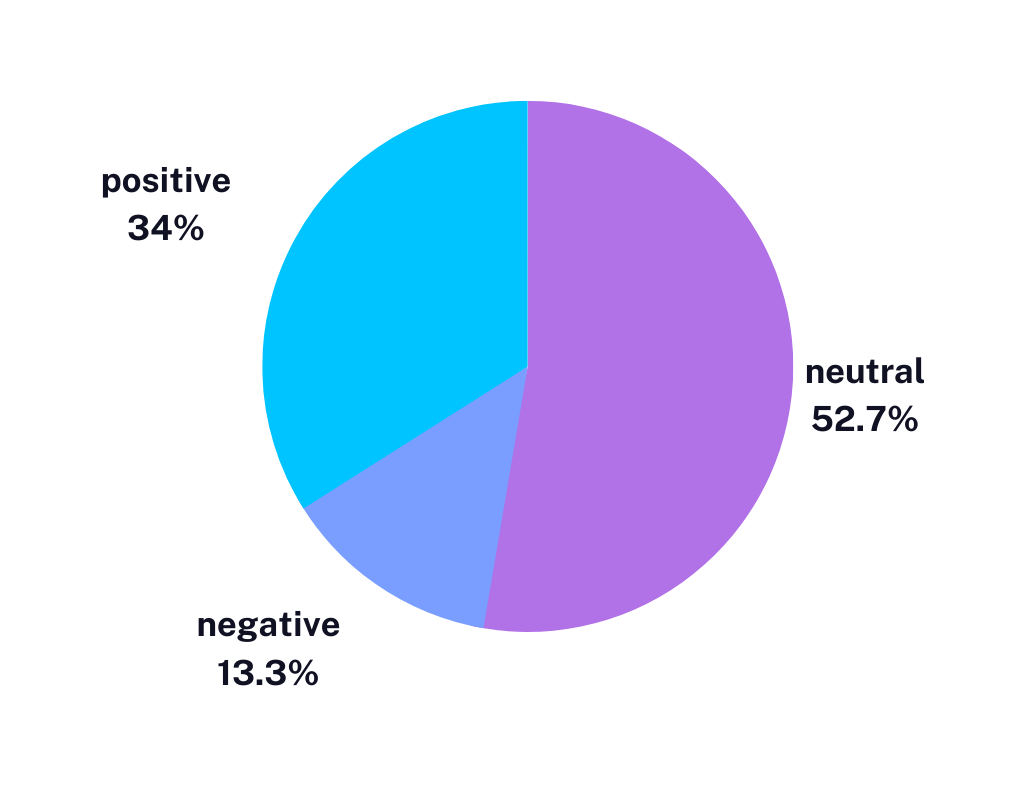
Sentiment Score Calculation
Next, I sorted all the tweets into separate files based on the previously categorized types of emotions, and calculated the sentiment score for each tweet.
Steps
l VaderSentiment
l SentimentIntensityAnalyzer
Positive Tweets
Word Cloud of Positive Tweets
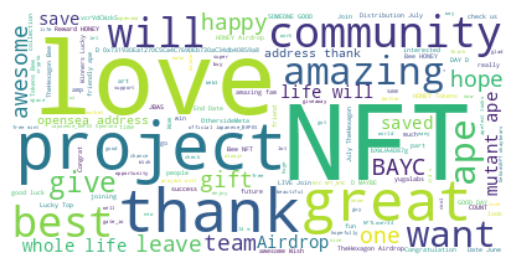
Most Frequent Words in positive tweets
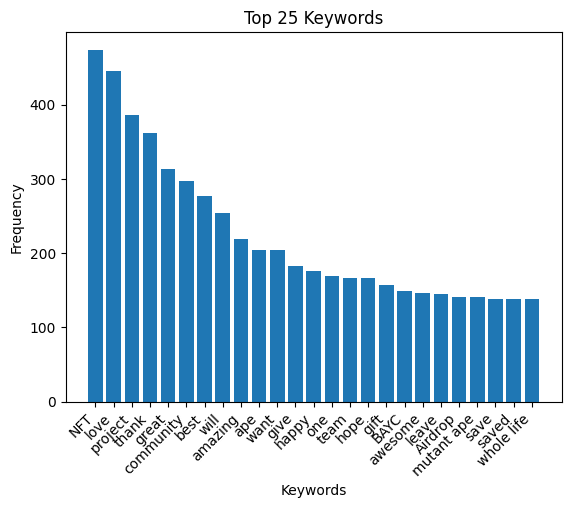
Words such as “love”, “thank”, “great”, “best”, “amazing”, “happy”, and “awesome” suggest positive emotions or gratitude towards BAYC. Words such as “project”, “team”, and “gift” suggest expectations or eagerness to participate in this project. While frequent words like “leave”, “hope”, and “save” may be a little bit far from this subject, we guess it is a way of preaching. It can also prove that BAYC is popular among the public.
Why do people like BAYC?
Apart from quantitative analysis, we also conducted qualitative analysis on the tweets in this category. We propose that BAYC fans might treasure this collection because of its Investment Potential, Unique and Creative Artwork, and the good feelings it brings.
They believe that the project has the potential to be highly rewarding and successful, and they are excited about the future prospects. The choice of ape is also unexpected, which adds to the uniqueness of the piece.
They treasure it as valuable since this artwork uses pixel art as an expression technique. The choice of ape is also out of their expectation that make the work more special.
They find the works to be beautiful, amazing, outstanding, and impressive. As fans, they congratulate the artists on their success and express their gratitude for creating such wonderful artworks.
Negative Tweets
Word Cloud of Negative Tweets

Most Frequent Words in negative tweets
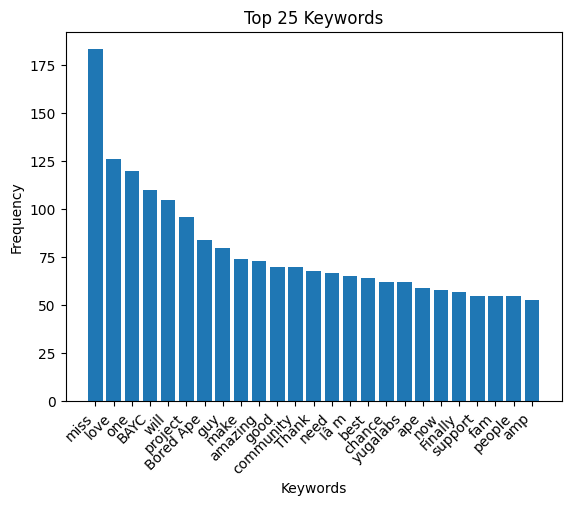
As for negative tweets, “miss” is the most frequently mentioned word, which indicates that people may generate negative attitudes because of missing certain opportunities or events. Words such as “project”, “chance”, and “need” imply that some people believe that BAYC needs some improvements in the future.
Why do people don't like BAYC?
Some people may simply not be drawn to the aesthetics or concept of BAYC. They even use some words like “ugly”, “mutant art” and “horrible” to describe this collection.
Some people may take issue with the environmental impact of NFTs or the perceived elitism and exclusivity of certain NFT projects. They have concerns about the popularity of BAYC being a cultural invasion including racism, sexism, or elitism.
People may have concerns about scams, fraud, and lack of regulation, which could be reasons why some people do not like BAYC.
l Rumor
l sell stolen assets
l fake
l hacked
l dangerous
Based on the market’s reaction to NFTs and a sentiment analysis performed on a dataset of tweets, it is clear that public attitudes towards NFTs are polarized. On one hand, some people have positive feelings towards NFTs due to their potential investment value or unique artistic features, while on the other hand, some people have biases against NFTs due to negative reports (such as ethical or security concerns). These significant differences in ideas mainly revolve around two points: the commercial value behind NFTs and the aesthetic presentation of this emerging art form.
